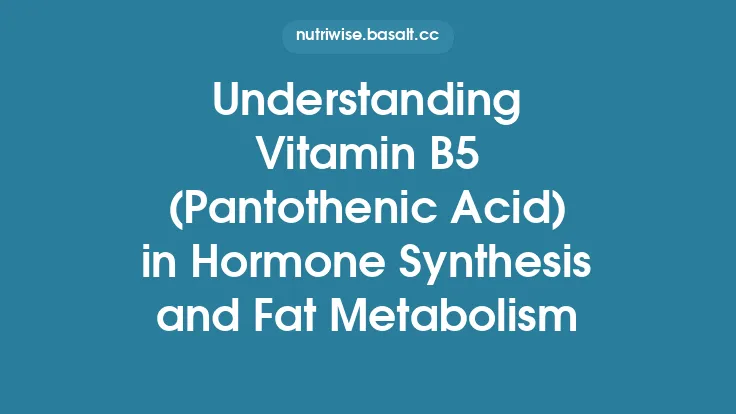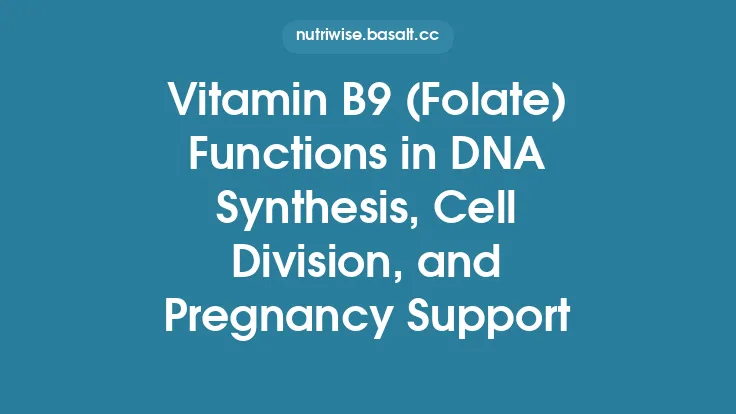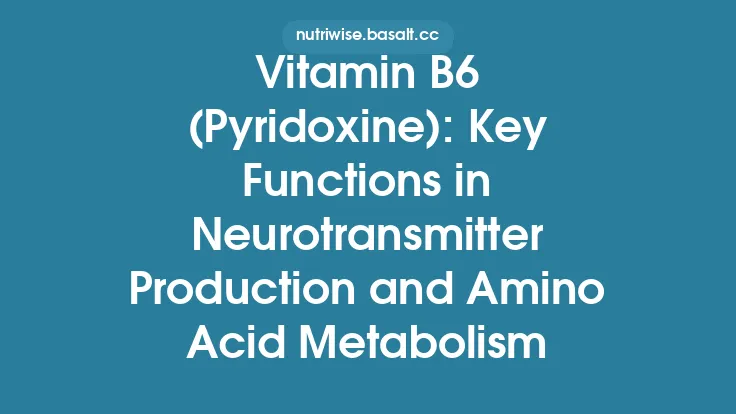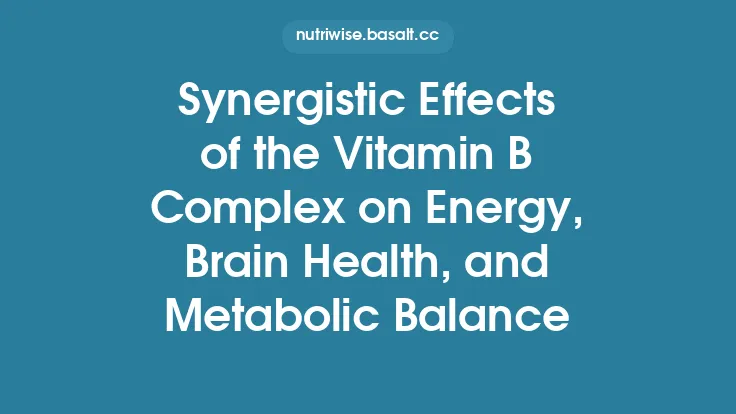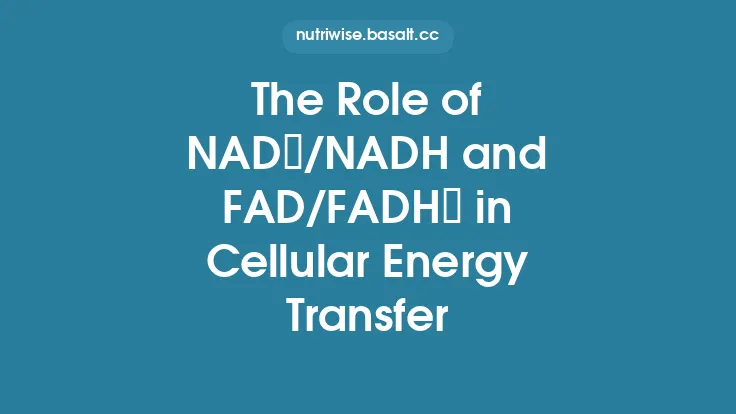Vitamin B3, commonly known as niacin, is a water‑soluble micronutrient that serves as the structural backbone for two of the most essential redox cofactors in human biology: nicotinamide adenine dinucleotide (NAD⁺) and its phosphorylated counterpart NADP⁺. Through these cofactors, niacin directly fuels the catabolism of carbohydrates, fats, and proteins, and it also powers a suite of enzymatic reactions that safeguard genomic integrity. Understanding how niacin integrates into metabolism and DNA repair provides a clear picture of why adequate intake is critical for health across the lifespan.
Chemical Forms and Metabolic Interconversion
Niacin exists in three principal dietary forms:
| Form | Chemical name | Primary source | Metabolic fate |
|---|---|---|---|
| Nicotinic acid | 3‑pyridinecarboxylic acid | Meat, fish, fortified grains | Converted to nicotinamide (NAM) via amidation; can also be phosphorylated to nicotinic acid mononucleotide (NaMN) |
| Nicotinamide (niacinamide) | 3‑pyridinecarboxamide | Milk, legumes, nuts | Direct precursor for NAD⁺ synthesis via the salvage pathway |
| Nicotinamide riboside (NR) | Nicotinamide riboside | Trace amounts in milk | Enters the NAD⁺ salvage pathway after phosphorylation to NMN (nicotinamide mononucleotide) |
All three converge on the Preiss‑Handler pathway (nicotinic acid → NaMN → NaAD → NAD⁺) or the salvage pathway (nicotinamide → NMN → NAD⁺). The body can also recycle nicotinamide released from NAD⁺‑consuming reactions back into the salvage pathway, ensuring a relatively closed loop that minimizes net niacin loss.
Absorption, Transport, and Cellular Uptake
- Intestinal absorption – Niacin is absorbed primarily in the jejunum via passive diffusion at high concentrations and via the sodium‑dependent transporter SLC5A8 at physiological levels. Nicotinamide riboside utilizes the Equilibrative Nucleoside Transporter 1 (ENT1).
- Portal circulation – After absorption, niacin enters the portal vein bound loosely to plasma proteins. Hepatocytes are the first major site of conversion to NAD⁺/NADP⁺.
- Systemic distribution – NAD⁺ itself does not cross cell membranes efficiently; instead, cells rely on intracellular synthesis from circulating precursors. The Nicotinamide Transporter (SLC12A8) and NRK1/2 kinases facilitate uptake of nicotinamide and NR, respectively.
- Subcellular compartmentalization – NAD⁺ pools are compartmentalized into cytosol, mitochondria, and nucleus. Mitochondrial NAD⁺ is generated by the mitochondrial nicotinamide nucleotide transhydrogenase (NNT) and by import of NMN via the SLC25A51 transporter.
NAD⁺/NADP⁺: The Redox Engine of Metabolism
Central Catabolic Pathways
- Glycolysis – Glyceraldehyde‑3‑phosphate dehydrogenase (GAPDH) oxidizes glyceraldehyde‑3‑phosphate, reducing NAD⁺ to NADH. The regeneration of NAD⁺ by lactate dehydrogenase (LDH) or mitochondrial shuttles is essential for continued glycolytic flux.
- Tricarboxylic Acid (TCA) Cycle – Multiple dehydrogenases (isocitrate dehydrogenase, α‑ketoglutarate dehydrogenase, malate dehydrogenase) depend on NAD⁺ to accept electrons, producing NADH that fuels oxidative phosphorylation.
- β‑Oxidation – Acyl‑CoA dehydrogenases generate FADH₂, but the subsequent steps (hydroxyacyl‑CoA dehydrogenase) require NAD⁺, linking fatty‑acid catabolism to the NAD⁺ pool.
- Amino‑acid catabolism – Transamination and deamination reactions often produce NADH, especially in the catabolism of glutamate to α‑ketoglutarate.
Anabolic and Antioxidant Roles of NADP⁺
- Pentose Phosphate Pathway (PPP) – Glucose‑6‑phosphate dehydrogenase (G6PD) reduces NADP⁺ to NADPH, providing reducing equivalents for biosynthetic reactions (fatty‑acid synthesis, cholesterol synthesis) and for regeneration of reduced glutathione (GSH), a primary cellular antioxidant.
- Fatty‑acid synthesis – NADPH supplies the hydride ions required for the reductive steps catalyzed by fatty‑acid synthase.
- Detoxification – Cytochrome P450 enzymes and glutathione reductase rely on NADPH to neutralize xenobiotics and reactive oxygen species (ROS).
Niacin‑Dependent DNA Repair Mechanisms
Poly(ADP‑ribose) Polymerases (PARPs)
PARP‑1 and PARP‑2 detect DNA strand breaks and catalyze the transfer of ADP‑ribose units from NAD⁺ to target proteins, forming poly(ADP‑ribose) (PAR) chains. This PARylation:
- Recruits DNA‑repair factors (XRCC1, DNA ligase III) to the lesion.
- Alters chromatin structure to facilitate access.
- Consumes NAD⁺, linking DNA repair directly to cellular energy status.
Excessive DNA damage can deplete NAD⁺, leading to energy failure and cell death—a phenomenon exploited in cancer therapy (PARP inhibitors).
Sirtuins (SIRT1‑7)
Sirtuins are NAD⁺‑dependent deacetylases and ADP‑ribosyltransferases that modulate:
- Base excision repair (BER) – SIRT1 deacetylates and activates APE1, enhancing removal of oxidized bases.
- Double‑strand break repair – SIRT6 promotes DNA‑PKcs activity and facilitates homologous recombination by deacetylating histone H3K56.
- Chromatin stability – SIRT1 and SIRT6 maintain heterochromatin, reducing the likelihood of spontaneous DNA breaks.
Because sirtuin activity is directly proportional to NAD⁺ availability, niacin status influences the efficiency of multiple repair pathways.
NAD⁺‑Dependent Kinases and Other Repair Enzymes
- ADP‑ribosyltransferase (ART) family – Some ART enzymes, distinct from PARPs, modify histones and repair proteins in an NAD⁺‑dependent manner.
- NAD⁺‑dependent DNA ligases – In bacteria, NAD⁺ serves as a cofactor for DNA ligase; in humans, ATP‑dependent ligases predominate, but the principle underscores the evolutionary link between NAD⁺ and genome maintenance.
Niacin, Gene Regulation, and Epigenetics
Beyond direct repair, niacin influences gene expression through:
- Sirtuin‑mediated deacetylation of transcription factors (p53, FOXO, NF‑κB), modulating stress responses, apoptosis, and inflammation.
- NAD⁺‑dependent ADP‑ribosylation of histones, altering chromatin accessibility.
- Regulation of the NAD⁺ salvage pathway itself via feedback inhibition of NAMPT, the rate‑limiting enzyme converting nicotinamide to NMN.
These mechanisms illustrate how niacin status can shape cellular phenotypes beyond pure metabolism.
Dietary Sources, Recommended Intakes, and Bioavailability
| Food Category | Representative Sources | Approx. Niacin Content (mg/100 g) |
|---|---|---|
| Animal proteins | Chicken breast, turkey, tuna, beef liver | 8–15 |
| Fish & seafood | Salmon, anchovies, sardines | 5–12 |
| Legumes & nuts | Peanuts, lentils, soybeans | 2–5 |
| Grains (fortified) | Breakfast cereals, enriched breads | 10–20 (added) |
| Vegetables | Mushrooms, green peas | 1–3 |
Recommended Dietary Allowance (RDA) (US NIH, 2023):
- Adult men: 16 mg NE (niacin equivalents) per day
- Adult women: 14 mg NE per day
- Pregnant women: 18 mg NE per day
- Lactating women: 17 mg NE per day
*Niacin equivalents* account for the fact that 1 mg of nicotinic acid = 1 mg NE, while 1 mg of nicotinamide = 1 mg NE, and 1 mg of tryptophan (an endogenous precursor) ≈ 0.06 mg NE.
Bioavailability is high (>70 %) for free nicotinic acid and nicotinamide. Food matrix effects are modest, but processing (e.g., milling, fortification) can increase niacin availability by converting bound forms (niacytin) to free forms.
Niacin Deficiency: Pellagra
A severe deficiency manifests as the classic “three D’s”:
- Dermatitis – Symmetrical, photosensitive rash on exposed skin, often hyperpigmented and scaly.
- Diarrhea – Chronic, watery stools with malabsorption of other nutrients.
- Dementia – Progressive neurocognitive decline, irritability, and, in advanced cases, psychosis.
If untreated, pellagra can be fatal. Populations at risk include:
- Individuals with chronic alcoholism (impaired absorption and increased urinary loss).
- Patients on isoniazid therapy (drug competes for pyridoxine and can deplete niacin stores).
- Those consuming diets heavily reliant on untreated corn (maize) lacking nixtamalization, which does not release bound niacin.
Toxicity, Upper Limits, and Adverse Effects
Niacin exhibits a bimodal safety profile:
- Nicotinic acid at pharmacologic doses (>50 mg/day) can cause flushing, pruritus, and, rarely, hepatotoxicity.
- Nicotinamide is far less likely to cause flushing but may still lead to hepatotoxicity at very high intakes (>3 g/day).
The Tolerable Upper Intake Level (UL) for adults is set at 35 mg/day for nicotinic acid equivalents, primarily to avoid flushing. Doses used to treat dyslipidemia (1–3 g/day) are administered under medical supervision with regular liver function monitoring.
Supplementation Forms and Their Distinct Properties
| Form | Chemical nature | Primary effect | Typical dose range |
|---|---|---|---|
| Nicotinic acid | Free acid | Increases NAD⁺, induces flushing (via prostaglandin D₂) | 50 mg–3 g (therapeutic) |
| Nicotinamide (niacinamide) | Amide | Increases NAD⁺ without flushing; used for skin conditions | 10 mg–500 mg |
| Nicotinamide riboside (NR) | Nucleoside | Directly boosts NAD⁺ via salvage pathway; minimal flushing | 100 mg–300 mg |
| Inositol hexanicotinate (IHN) | “Flush‑free” niacin | Slowly releases nicotinic acid; controversial efficacy | 500 mg–2 g |
When selecting a supplement, consider the therapeutic goal (e.g., lipid lowering vs. NAD⁺ boosting) and tolerance to flushing.
Interactions with Medications and Health Conditions
- Statins – May increase the risk of niacin‑induced hepatotoxicity; liver enzymes should be monitored.
- Antihypertensives (e.g., clonidine) – Can exacerbate niacin‑induced flushing.
- Diabetes – High‑dose nicotinic acid can impair glucose tolerance; patients should monitor blood sugar.
- Renal impairment – Reduced clearance of nicotinamide metabolites may necessitate dose adjustment.
Clinical Applications Beyond Deficiency
- Hyperlipidemia – Nicotinic acid at 1–3 g/day reduces LDL‑cholesterol, triglycerides, and raises HDL‑cholesterol via inhibition of hepatic diacylglycerol acyltransferase‑2 and reduced VLDL secretion.
- Cardiovascular protection – By improving lipid profiles and enhancing endothelial NAD⁺‑dependent nitric oxide synthase (eNOS) activity, niacin may support vascular health.
- Neurodegeneration – NAD⁺ augmentation (via NR or nicotinamide) is under investigation for Alzheimer’s disease, Parkinson’s disease, and age‑related cognitive decline, largely through sirtuin activation and mitigation of oxidative DNA damage.
- Skin disorders – Topical nicotinamide reduces inflammation in acne, rosacea, and photo‑aging, reflecting its role in DNA repair and barrier function.
Practical Recommendations for Optimizing Niacin Status
- Eat a balanced diet rich in lean meats, fish, legumes, and fortified grains to meet the RDA without supplementation.
- Consider a low‑dose supplement (e.g., 20–30 mg nicotinamide) if dietary intake is borderline, especially for older adults where NAD⁺ levels naturally decline.
- Use flushing‑free forms (nicotinamide or NR) for general health and anti‑aging purposes; reserve nicotinic acid for clinically indicated lipid management.
- Monitor liver function when using pharmacologic doses (>500 mg/day) and avoid concurrent hepatotoxic drugs when possible.
- Address risk factors for deficiency – limit chronic alcohol intake, ensure adequate protein intake, and treat conditions that impair absorption (e.g., celiac disease).
Concluding Perspective
Niacin’s centrality to both energy metabolism and genomic maintenance makes it a linchpin of cellular health. By supplying the NAD⁺/NADP⁺ cofactors that drive catabolic and anabolic reactions, and by fueling DNA‑repair enzymes such as PARPs and sirtuins, adequate niacin intake safeguards the biochemical foundation upon which all physiological processes rest. Maintaining sufficient niacin—through diet, judicious supplementation, and awareness of interactions—ensures that the body’s metabolic engine runs smoothly while its genome remains protected against the relentless onslaught of oxidative and replication‑associated damage. In the broader context of the vitamin B complex, niacin stands out as the indispensable bridge between metabolism and the preservation of genetic fidelity.
